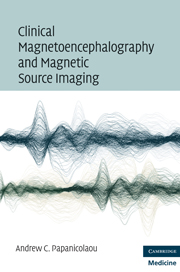Book contents
- Frontmatter
- Contents
- Contributors
- Preface
- Section 1 The method
- Section 2 Spontaneous brain activity
- Section 3 Evoked magnetic fields
- 19 Recording evoked magnetic fields (EMFs)
- 20 Somatosensory evoked fields (SEFs)
- 21 Movement-related magnetic fields (MRFs) – motor evoked fields (MEFs)
- 22 Auditory evoked magnetic fields (AEFs)
- 23 Visual evoked magnetic fields (VEFs)
- 24 Language-related brain magnetic fields (LRFs)
- 25 Alternative techniques for evoked magnetic field data – future directions
- Postscript: Future applications of clinical MEG
- References
- Index
24 - Language-related brain magnetic fields (LRFs)
from Section 3 - Evoked magnetic fields
Published online by Cambridge University Press: 01 March 2010
- Frontmatter
- Contents
- Contributors
- Preface
- Section 1 The method
- Section 2 Spontaneous brain activity
- Section 3 Evoked magnetic fields
- 19 Recording evoked magnetic fields (EMFs)
- 20 Somatosensory evoked fields (SEFs)
- 21 Movement-related magnetic fields (MRFs) – motor evoked fields (MEFs)
- 22 Auditory evoked magnetic fields (AEFs)
- 23 Visual evoked magnetic fields (VEFs)
- 24 Language-related brain magnetic fields (LRFs)
- 25 Alternative techniques for evoked magnetic field data – future directions
- Postscript: Future applications of clinical MEG
- References
- Index
Summary
Overview of LRFs
When language stimuli are presented acoustically or visually, not only is neurophysiological activation elicited in the primary auditory and visual cortices, but also in a number of areas of the brain responsible for language functions. The characteristics of this activation depends to a certain extent upon the task that the patient is asked to perform on these stimuli, typically appearing as late language-related brain magnetic fields (LRFs) after the primary sensory components. These late components localize to language-related areas of the brain regardless of the modality of stimulus presentation. LRFs are repeatable and have been validated by comparison with the Wada procedure and electrocortical stimulation mapping. Most LRF studies have focused on receptive language areas, although frontal expressive language and basal temporal areas have been studied as well.
Recordings of LRFs are indicated clinically to (1) determine the language-dominant hemisphere and (2) identify cortex indispensable for language functions in patients with either organic or functional brain diseases before surgical interventions such as craniotomy, stereotactic, or radiosurgical procedures. Noninvasive preoperative mapping is particularly important in view of the often aberrant anatomic layout of the brain mechanism for language functions associated with neurological disorders and brain damage.
- Type
- Chapter
- Information
- Clinical Magnetoencephalography and Magnetic Source Imaging , pp. 144 - 156Publisher: Cambridge University PressPrint publication year: 2009



